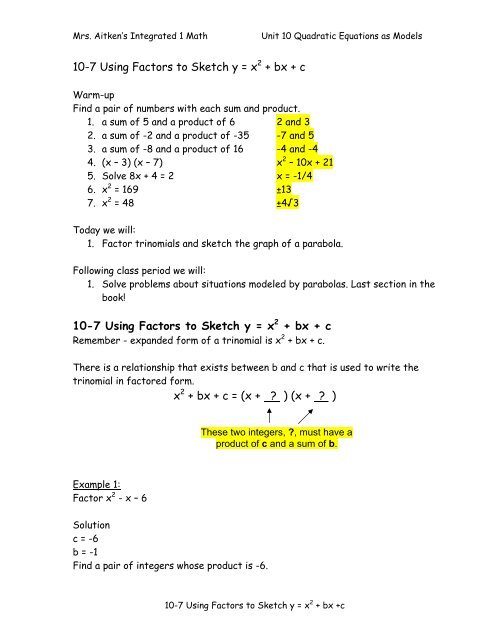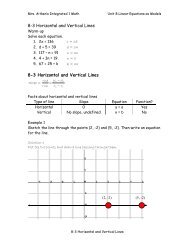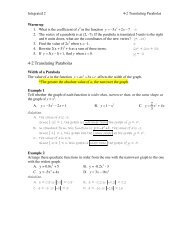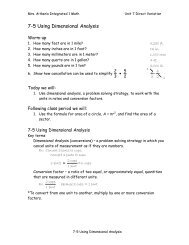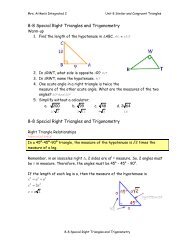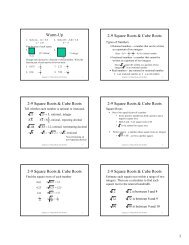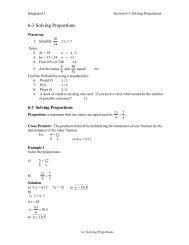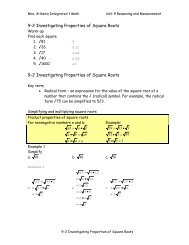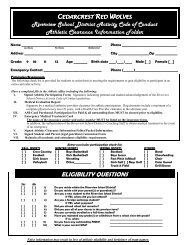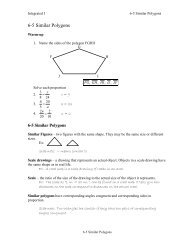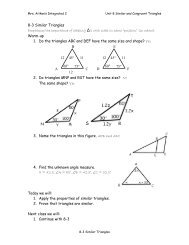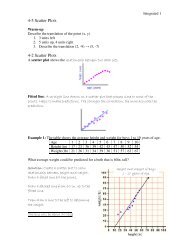10-7 Using Factors to Sketch y = x 2 + bx + c notes
10-7 Using Factors to Sketch y = x 2 + bx + c notes
10-7 Using Factors to Sketch y = x 2 + bx + c notes
You also want an ePaper? Increase the reach of your titles
YUMPU automatically turns print PDFs into web optimized ePapers that Google loves.
Mrs. Aitken’s Integrated 1 Math<br />
Unit <strong>10</strong> Quadratic Equations as Models<br />
<strong>10</strong>-7 <strong>Using</strong> <strong>Fac<strong>to</strong>rs</strong> <strong>to</strong> <strong>Sketch</strong> y = x 2 + <strong>bx</strong> + c<br />
Warm-up<br />
Find a pair of numbers with each sum and product.<br />
1. a sum of 5 and a product of 6 2 and 3<br />
2. a sum of -2 and a product of -35 -7 and 5<br />
3. a sum of -8 and a product of 16 -4 and -4<br />
4. (x – 3) (x – 7) x 2 – <strong>10</strong>x + 21<br />
5. Solve 8x + 4 = 2 x = -1/4<br />
6. x 2 = 169 ±13<br />
7. x 2 = 48 ±4√3<br />
Today we will:<br />
1. Fac<strong>to</strong>r trinomials and sketch the graph of a parabola.<br />
Following class period we will:<br />
1. Solve problems about situations modeled by parabolas. Last section in the<br />
book!<br />
<strong>10</strong>-7 <strong>Using</strong> <strong>Fac<strong>to</strong>rs</strong> <strong>to</strong> <strong>Sketch</strong> y = x 2 + <strong>bx</strong> + c<br />
Remember - expanded form of a trinomial is x 2 + <strong>bx</strong> + c.<br />
There is a relationship that exists between b and c that is used <strong>to</strong> write the<br />
trinomial in fac<strong>to</strong>red form.<br />
x 2 + <strong>bx</strong> + c = (x + ? ) (x + ? )<br />
These two integers, ?, must have a<br />
product of c and a sum of b.<br />
Example 1:<br />
Fac<strong>to</strong>r x 2 - x – 6<br />
Solution<br />
c = -6<br />
b = -1<br />
Find a pair of integers whose product is -6.<br />
<strong>10</strong>-7 <strong>Using</strong> <strong>Fac<strong>to</strong>rs</strong> <strong>to</strong> <strong>Sketch</strong> y = x 2 + <strong>bx</strong> +c
Mrs. Aitken’s Integrated 1 Math<br />
Unit <strong>10</strong> Quadratic Equations as Models<br />
You can pick the order <strong>to</strong> guess and check…check using FOIL.<br />
<strong>Fac<strong>to</strong>rs</strong> of -6 Plug these in and use guess and check <strong>to</strong> figure out your answer.<br />
Use FOIL <strong>to</strong> check your answer<br />
-2 • 3 (x - 2) (x + 3) x 2 + 3x - 2x - 6 = x 2 + x - 6 nope<br />
-3 • 2 (x - 3) (x + 2) x 2 + 2x - 3x - 6 = x 2 - x - 6 YES<br />
-1 • 6 (x - 1) (x + 6) x 2 + 6x - x - 6 = x 2 + 5x - 6 nope<br />
-6 • 1 (x - 6) (x + 1) x 2 + x - 6x - 6 = x 2 - 5x - 6 nope<br />
(x – 3)(x + 2)<br />
Example 2:<br />
Fac<strong>to</strong>r x 2 + 7x – 18<br />
Solution<br />
c = -18<br />
b = 7<br />
You can pick the order <strong>to</strong> guess and check.<br />
<strong>Fac<strong>to</strong>rs</strong> of -18 Plug these in and use guess and check <strong>to</strong> figure out your answer.<br />
Use FOIL <strong>to</strong> check your answer<br />
-1 • 18 (x - 1) (x + 18) x 2 + 18x - x - 18 = x 2 + 17x - 18 nope<br />
-18 • 1 (x - 18) (x + 1) x 2 + x - 18x - 18 = x 2 - 17x - 18 nope<br />
-2 • 9 (x - 2) (x + 9) x 2 + 9x - 2x - 18 = x 2 +7x - 18 YES<br />
-9 • 2 (x - 9) (x + 2) x 2 + 2x - 9x - 18 = x 2 - 7x - 18 nope<br />
-3 • 6 (x - 3) (x + 6) x 2 + 6x - 3x - 18 = x 2 + 3x - 18 nope<br />
-6 • 3 (x - 6) (x + 3) x 2 + 3x - 6x - 18 = x 2 - 3x - 18 nope<br />
(x – 2)(x + 9)<br />
Side-note: Notice -2(9) = -18
Mrs. Aitken’s Integrated 1 Math<br />
Unit <strong>10</strong> Quadratic Equations as Models<br />
Example 3:<br />
Fac<strong>to</strong>r x 2 + <strong>10</strong>x + 24<br />
Solution<br />
c = 24<br />
b = <strong>10</strong><br />
<strong>Fac<strong>to</strong>rs</strong> of 24 Plug these in and use guess and check <strong>to</strong> figure out your answer.<br />
Use FOIL <strong>to</strong> check your answer<br />
6 • 4 (x + 6) (x + 4) x 2 + 6x +4x + 24 = x 2 + <strong>10</strong>x + 24 YES<br />
2 • 12 (x + 2) (x + 12) x 2 + 12x + 2x + 24 = x 2 + 14x + 24 nope<br />
3 • 8 (x + 3) (x + 8) x 2 + 8x + 3x + 24 = x 2 +11x + 24 nope<br />
1 • 24 (x + 1) (x + 24) x 2 + 24x + x + 24 = x 2 + 25x + 24 nope<br />
-6 • -4 (x - 6) (x - 4) x 2 - 4x - 6x + 24 = x 2 - <strong>10</strong>x + 24 nope<br />
-2 • -12 (x - 2) (x - 12) x 2 - 12x - 2x + 24 = x 2 - 14x + 24 nope<br />
-3 • -8 (x - 3) (x - 8) x 2 - 3x - 8x + 24 = x 2 - 11x + 24 nope<br />
-1 • -24 (x - 1) (x - 24) x 2 - 24x - x + 24 = x 2 - 25x + 24 nope<br />
(x + 6)(x + 4)<br />
Example 4:<br />
Fac<strong>to</strong>r x 2 - 5x + <strong>10</strong><br />
Solution 4<br />
<strong>Fac<strong>to</strong>rs</strong> of <strong>10</strong><br />
Plug these in and use guess and check <strong>to</strong> figure out your answer.<br />
Use FOIL <strong>to</strong> check your answer<br />
2 • 5 (x + 2) (x + 5) x 2 + 5x +2x + <strong>10</strong> = x 2 + 7x + <strong>10</strong> nope<br />
1 • <strong>10</strong> (x + 1) (x + <strong>10</strong>) x 2 + <strong>10</strong>x + x + <strong>10</strong> = x 2 + 11x + <strong>10</strong> nope<br />
-2 • -5 (x - 2) (x - 5) x 2 - 5x + 2x + <strong>10</strong> = x 2 - 3x + <strong>10</strong> nope<br />
-1 • -<strong>10</strong> (x - 1) (x - <strong>10</strong>) x 2 - <strong>10</strong>x - x + <strong>10</strong> = x 2 - 11x + <strong>10</strong> nope<br />
Unfac<strong>to</strong>rable<br />
* Sometimes a trinomial cannot be fac<strong>to</strong>red.<br />
<strong>10</strong>-7 <strong>Using</strong> <strong>Fac<strong>to</strong>rs</strong> <strong>to</strong> <strong>Sketch</strong> y = x 2 + <strong>bx</strong> +c
Mrs. Aitken’s Integrated 1 Math<br />
Unit <strong>10</strong> Quadratic Equations as Models<br />
<strong>Sketch</strong>ing the graph of y = x 2 + <strong>bx</strong> + c<br />
You can make a reasonably accurate sketch of a parabola by determining the<br />
line of symmetry, coordinated of the vertex, and the x- and y-intercepts of the<br />
graph from the equation of the parabola.<br />
Example 5: - Use the vertex, the intercepts, and symmetry <strong>to</strong> sketch the graph<br />
of y = x 2 - 2x – 3.<br />
Solution<br />
Step 1 – find the equation of the line of symmetry.<br />
x = -b/2a (Formula for the line of symmetry)<br />
b = -2<br />
a = 1<br />
x = -(-2)/2(1) = 1<br />
The equation of the line of symmetry is x = 1.<br />
Step 2 - Find the coordinates of the vertex.<br />
From the line of symmetry found in step 1, the x-coordinate of the vertex is 1.<br />
Substitute 1 for x in<strong>to</strong> the equation.<br />
y = x 2 - 2x – 3<br />
y = 1 2 – 2(1) – 3<br />
y = 1 – 2 – 3<br />
y = -4<br />
The vertex is (1, -4).<br />
Step 3 – Find the intercepts<br />
a. Find the y-intercept. Set x = 0 and solve for y.<br />
y = 0 2 – 2(0) – 3<br />
y = -3<br />
(0, -3)<br />
b. Find the x-intercepts<br />
Fac<strong>to</strong>r the right side of the equation.<br />
y = x 2 - 2x – 3<br />
y = (x – 3)(x + 1)<br />
x – 3 = 0 x + 1 = 0<br />
x = 3 x = -1<br />
(3, 0) (-1, 0)<br />
Use the zero product property <strong>to</strong> set<br />
each fac<strong>to</strong>r <strong>to</strong> 0 and solve.<br />
<strong>10</strong>-7 <strong>Using</strong> <strong>Fac<strong>to</strong>rs</strong> <strong>to</strong> <strong>Sketch</strong> y = x 2 + <strong>bx</strong> +c
Mrs. Aitken’s Integrated 1 Math<br />
Unit <strong>10</strong> Quadratic Equations as Models<br />
Step 4 – Use the vertex, intercepts, and symmetry <strong>to</strong> sketch the parabola.<br />
By symmetry, the point (2, -3)<br />
is on the parabola.<br />
<strong>10</strong>-7 <strong>Using</strong> <strong>Fac<strong>to</strong>rs</strong> <strong>to</strong> <strong>Sketch</strong> y = x 2 + <strong>bx</strong> +c


